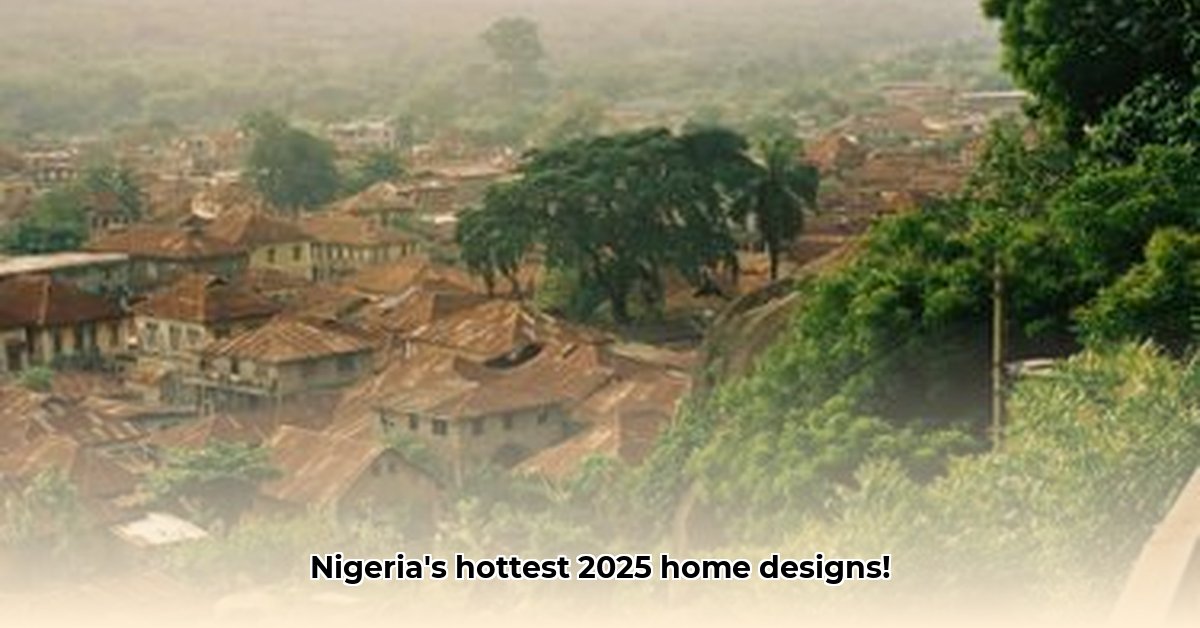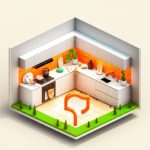Imagine a place where modern skyscrapers rise beside centuries-old homes—a dynamic mix of old and new. That’s the Nigerian real estate landscape. This article guides you through the exciting realm of modern Nigerian house designs anticipated in 2025, exploring everything from chic city dwellings to sprawling eco-friendly residences. We will discuss costs, styles, and strategies for building your dream home sustainably. For more modern Nigerian house design inspiration, check out this resource. Prepare to be captivated by the innovation and charm of Nigeria’s contemporary architecture.
Nigerian Modern House Designs: Architectural Innovations
A 2025 Snapshot: Tradition Meets Contemporary Living
Nigeria’s housing sector experiences substantial growth, fueled by urban expansion, rising incomes, and advanced construction technologies, blending classic styles with global trends to modernize homes. This evolution results in Nigerian modern house designs that integrate sleek, modern aesthetics with rich, textured fabrics, representing a fusion of heritage and innovation. What defines these homes? Let’s delve into the specifics that make them stand out.
Key Trends Shaping the Modern Nigerian Home: Sustainable Materials and Smart Tech
Several factors drive the transformations in Nigerian modern homes. Sustainability is a crucial element, evident in the rising adoption of solar panels and rainwater harvesting, becoming standard features. These eco-conscious additions enhance the appeal of homes while minimizing their environmental impact. Smart home technologies are also gaining popularity, providing homeowners with automated lighting, enhanced security, and climate control.
Smart home features offer long-term savings on energy bills, aligning with affordability as a key consideration in Nigeria. Modular and prefabricated homes are gaining traction due to their faster construction times and cost-effectiveness, making modern design more accessible across various budget levels. Expect to see a blend of open-concept designs, minimalist aesthetics, and a focus on natural light.
Styles and Costs: Diverse Housing Options
A defining aspect of Nigeria’s housing market is its extensive diversity, offering everything from luxurious duplexes in Lagos to quaint bungalows in smaller towns. This array of styles and sizes caters to a broad range of financial capabilities. Prices can vary significantly based on location, property size, material selection, and the integration of smart home technology. Understanding these variables is essential for buyers and builders alike.
Cost Breakdown:
| Feature | Cost Considerations |
|---|---|
| Location (Lagos vs. Abuja) | Major cities like Lagos and Abuja have higher real estate prices. |
| Size (Square Footage) | Larger homes increase construction and material expenses. |
| Materials (Local vs. Imported) | Imported materials can increase the overall cost of construction. |
| Smart Home Features | Integration adds to the initial expense but boosts future value. |
| Sustainable Features | Requires higher initial spending but offers long-term economic advantages. |
Popular Styles:
- Bungalows: Single-story homes emphasizing simplicity and functionality.
- Duplexes: Two-story structures often divided into separate living spaces.
- Apartments: Multi-unit dwellings popular in urban areas.
- Terraced Houses: Row houses offering affordable urban living.
- Mansions: Large, luxurious homes found in affluent neighborhoods.
- Container Homes: Eco-friendly and cost-effective homes made from repurposed shipping containers.
- Glass Houses: Modern homes incorporating large expanses of glass for natural light.
The Masterminds Behind the Modern Makeover: Influential Figures
Several key players shape the evolution of modern Nigerian house designs:
- Real Estate Developers: Drive the market by integrating sustainable methods and smart tech.
- Architects and Designers: Blend Nigerian elements with modern styles, creating functional homes.
- Homebuyers: Demand for sustainable and smart features influences design trends.
- Government and Regulatory Bodies: Shape new construction through regulations and incentives (like tax breaks for green builds).
Looking Ahead: Bright and Smart Housing Future
The future of Nigerian modern homes anticipates advancements in smart home technology, making it more affordable and prevalent. We’ll also likely see increased adoption of eco-friendly building materials and practices, driven by government initiatives and consumer demand for sustainable building and modular construction. These elements will be critical in addressing the demand for affordable housing and reflecting Nigeria’s diverse cultural landscape.
The evolution of Nigerian modern house design reflects a mix of tradition and progress, adapting global trends to Nigeria’s unique needs and desires.
How to Calculate Long-Term Cost-Effectiveness of Modern vs Traditional Nigerian House Designs in Nigeria
Are you planning to build a home in Nigeria? The decision between modern and traditional designs greatly affects long-term expenses, making it a pivotal decision.
Understanding the Variables: Project Scope and Design
Traditional Nigerian homes, often constructed with locally sourced materials and labor, offer a distinct aesthetic. Modern designs utilize prefabrication, advanced technologies, and sustainable materials. Which provides better value over time?
The most effective choice relies on:
- Project Scale: The size of the project, from modest to multi-story, impacts construction and expense.
- Design Complexity: Intricate designs boost costs, regardless of the construction method.
- Material Availability: Access to materials affects build times and project expenses.
- Skilled Labor: Traditional builds may need more skilled labor, while modern construction needs specialized workers.
- Long-Term Maintenance: The lifespan and upkeep vary between materials and construction types.
Calculating Long-Term Costs: A Step-by-Step Guide
Calculating the Long-Term Cost-Effectiveness of Modern vs Traditional Nigerian House Designs requires a methodical approach:
- Initial Investment: Assess land, licenses, construction, and finishing costs for modern and traditional designs, including possible overruns.
- Material Costs: Detail materials for each design, comparing prices, availability, and longevity.
- Labor Costs: Estimate labor, factoring skill and time. Account for possible delays and financial impacts.
- Maintenance Budget: Budget maintenance over 20 years. Traditional designs might need frequent repairs, offsetting upfront savings. Modern materials may require less frequent specialized maintenance.
- Energy Efficiency: Analyze energy usage. Modern designs cut utility bills over time.
- Resale Value: Consider resale value. Modern, sustainable homes often have higher market prices.
- Comparative Analysis: Create a spreadsheet comparing the projected expense over 20 years for modern and traditional, including initial investment, maintenance, and energy.
- Risk Assessment: Account for delays, price changes, and building code revisions.
Modern vs. Traditional: Benefits and Drawbacks
| Feature | Modern Design | Traditional Design |
|---|---|---|
| Construction Time | Faster, utilizing modular and prefabricated components. | Slower, reliant on manual labor and on-site adjustments. |
| Initial Cost | Potentially Higher, due to advanced materials and technology. | Potentially Lower, leveraging local materials and conventional methods. |
| Long-Term Cost | Potentially Lower, due to energy efficiency and lower maintenance needs. | Potentially Higher, due to increased maintenance and energy consumption. |
| Maintenance | Generally Lower, with durable and modern material selections. | Generally Higher, with the need for frequent repairs and upkeep. |
| Sustainability | Typically Higher, with eco-friendly and energy-saving features. | Varies greatly, depending on the materials and energy considerations. |
| Design Changes | Less Flexibility, changes require adjustments to pre-designed components. | Greater Flexibility, with on-site modifications possible throughout the build. |
| Energy Efficiency | High, due to modern insulation, window technology, and smart home systems. | Low, often lacking proper insulation and efficient energy systems. |
| Materials | Often imported, processed, and designed for longevity and efficiency. | Locally sourced, natural materials like mud, wood, and thatch. |
| Resale Value | Higher resale value due to modern amenities and energy efficiency. | Lower resale value, especially in urban areas. |
Key Points:
- Modern designs offer potential long-term savings due to efficiency and reduced maintenance.
- Traditional designs may have lower upfront costs neutralized by maintenance over time.
- Detailed cost analysis, incorporating construction and ownership aspects, is key.
- Project-specific characteristics should determine construction methodology.
- Consult pros – architects, surveyors, and contractors – to get accurate cost and specific advice.
Sustainable Nigerian Home Building Practices: Eco Friendly Architecture
Nigeria’s need for housing requires innovative solutions, combining tradition with modern eco-friendly techniques. Local materials like bamboo gain popularity, and renewable energy like solar power is important. Successful results need materials, trained labor, and supportive policies. Cost and climate resilience are key.
Balancing Tradition and Sustainability: Eco-Conscious Designs
Imagine a building made with earth bricks, a cool, energy-efficient solution for Nigeria’s hot climate. This reflects the promise of sustainable Nigerian home building practices, blending traditional methods with modern eco-conscious designs for reduced environmental impact, affordability, and resilience.
Materials Matter: Green Building Materials
Material choice affects sustainability. Earth bricks are inexpensive, readily available, and offer thermal insulation. Bamboo is a lightweight yet strong alternative to timber. These choices reduce carbon output while supporting local economies. Consider using recycled materials whenever possible
- Glass Tile Shower Ideas to Create a Stunning Bathroom Space - December 7, 2025
- Glass Wall Tile Ideas for Kitchens and Bathrooms - December 6, 2025
- Glass Tile Bathroom: Create a Beautiful, Easy-Clean Space - December 5, 2025










